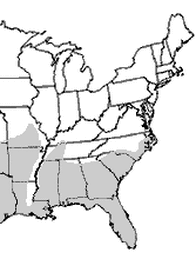Pigmy RattlesnakeSistrurus miliarius |

Custom Search
|
|
The Pigmy rattlesnake (Sistrurus miliarius) is a small venomous pit viper found in the southeastern part of the United States. The pigmy rattlesnake can be found in a variety of habitats including the everglades prairies, palmetto-pine flatwoods, mixed pine-hardwood forests, sandhills, borders of cypress ponds.
They are more often found in the vicinity of lakes and marshes and are seldom found in extremely dry habitats. They prefer to live in burrows, and will often occupy those vacated by Gopher Tortoises. They are called pit vipers because of the facial pits located between the eye and nostril. These pits are heat sensitive organs capable of detecting tiny temperature differences of less than 0.22 C (0.4 F), allowing them to detect potential prey. As their common name implies this is one of the smallest rattlesnake species, much smaller than the eastern diamondback rattlesnake or even the timber rattlesnake.The Pigmy rattlesnake is a short and relatively thick-bodied snake, their length ranges from 15 to 24 inches (38 to 60 cm). Although the largest known specimens measured up to 30 inches in length (76 cm). Their head is broad and triangular and the tail ends in a small rattle, which produces a faint sound resembling a buzzing insect and is often difficult to hear. Furthermore, the pigmy rattlesnake is unlikely to give any warning to people by rattling, they are more likely to remain motionless or move the head from side to side. The species is also known by a variety of other names like Bastard rattlesnake, Carolina ground rattlesnake, Brick red rattlesnake, Carolina pigmy rattlesnake, Catesby's small snake, dwarf rattlesnake, southern ground rattlesnake, southern pigmy rattlesnake, spotted rattler, spotted rattlesnake, southern rattlesnake, eastern pigmy rattlesnake, grey rattlesnake, ground rattler, ground rattlesnake, hog-nosed rattlesnake, little rattlesnake, miliary rattlesnake, North American smaller rattlesnake, oak-leaf rattler, pigmy ground rattlesnake, small rattlesnake, southeastern ground rattlesnake.
The background color is gray, marked with a row of large, dark circular spots down the center of its back and a fainter row of similar looking spots down each side. The pigmy rattlesnake has rough, keeled scales and its skin looks dull, not shiny. The species background color varies both geographically and within the sub-species populations, but in all subspecies, the belly is white with dark spots. The Carolina pigmy rattlesnake as pale gray to reddish background color with prominent markings and one or two rows of spots on the sides. The Dusky pigmy rattlesnake background color is dark gray with heavy black stippling obscuring pattern. The Western pigmy rattlesnake coloring is pale grayish-brown with blotches forming crossbars and two rows of spots on sides. There isn't much research in terms of their lifespan in the wild, but the snakes kept in captivity have lived up to 20 years, but those found in the wild are likely to live less. Subspecies
There are 3 subspecies of pigmy rattlesnakes currently recognized. Western pigmy rattlesnake - The United States in Mississippi and west through Louisiana and into eastern Texas, north into southeastern Oklahoma, Arkansas, southwestern Tennessee and southern Missouri. Carolina pigmy rattlesnake - These snakes are found in the USA from the southern parts of South Carolina, northwards into eastern North Carolina and west through central Georgia and central Alabama. Dusky pigmy rattlesnake - Found in the US from the extreme southern South Carolina through southern Georgia, west through southern Alabama and southeastern Mississippi and all of Florida. Venom / Bite The pigmy rattlesnake produces a venom that is strongly hemorrhagic and tissue damaging, but it doesn't have any neurotoxins in its composition. The hemotoxic venom causes the breakdown of blood cells and causes bruising and internal bleeding. Because of their smaller size, they are unable to produce much venom and have small fangs. So it's unlikely that it can deliver a fatal bite to a human adult, but in some rare cases, they have been fatal. Its bite can however, be very painful giving the victim quite an unpleasant time for a few days. However if the incident involves children may result in hospitalization, and there have been also reports of necrosis and loss of digits occurring. Diet / Feeding The pigmy rattlesnake like all other rattlesnakes is a carnivore, and their preys consist of many different animals, including mice, small rats, small squirrels, birds, and other reptiles like lizards, frogs, toads and even other snakes. They may also eat insects like centipedes and spiders as well. Reproduction Maturity comes relatively early for the species, and females can produce their first litter in as little as 24 months, although 3 to 4 years is a more typical age for the 1st reproduction. The pigmy rattlesnake is ovoviparous like most other pitvipers. What this means is that they give birth to live young rather than laying eggs which hatch months later. The mating season occurs during the spring, and the majority of female snakes will normally give birth between July and September. Females usually give birth to between 2 and 12 younglings with an average litter of 6. The young snakes only 5 to 7 inches in length and will grow gradually for the first two years, but are entirely independent from birth. The young pigmy rattlesnakes look slightly different from the adults usually, their coloration is lighter and the tip of their tail is yellow. Conservation / Threats The pigmy rattlesnake is classified as a Least Concern species (LC) on the IUCN Red List of Threatened Species, this means that they have a wide distribution and presumed large population. Despite their reputation, these snakes deserve protection, pigmy rattlesnake is a protected species in North Carolina and Tennessee.
|
Did You Know?
The highly venomous golden lancehead is found only in a tiny island off Brazil's coast. Scientific classification |
© 2014 Snake Facts About Us | Privacy Policy | Contact








